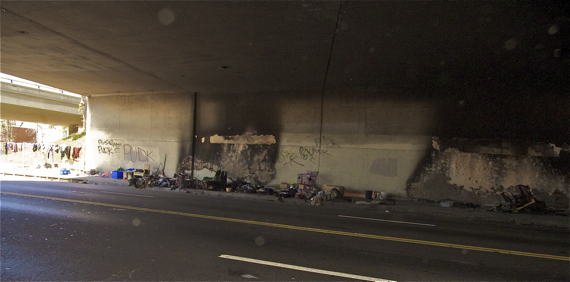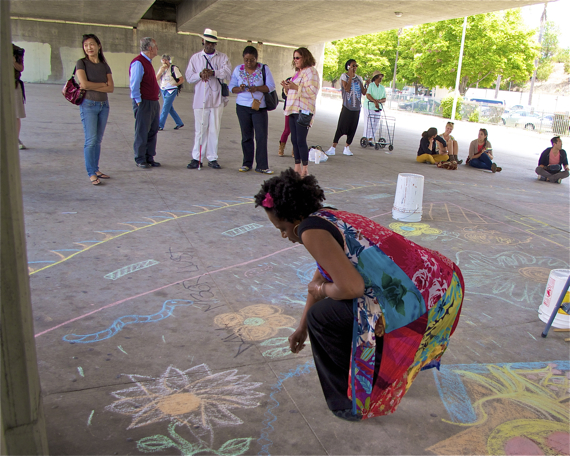
A few weeks ago, a significant hullabaloo was raised when developer Geoffrey Palmer proposed a walkway over the 110 Freeway that would allow residents of his apartment complex to walk between the buildings without having to traverse the underpass and the homeless encampment there.
Some were angered by the overt vilification of the homeless -- the developer wrote of fears that building residents would be targeted for crime -- and the very real squeezing out of the poor as the downtown area becomes more "livable" for those who can afford it.
Others argued that a walkway would harm the vibrancy of urban pedestrian life by preventing the activation of the underpass.
Whatever your take on the need for the walkway, it is hard to argue with the notion that underpasses generally suck for pedestrians.
Dark and neglected, they often feel like filthy, trash-filled no-man's lands.
And, their isolation from the "eyes on the street" that businesses, residences, and other active structures/spaces offer can give them a creepy aura. The greater the accumulation of trash (and, in particular, human waste and other mysterious fluid trails on the pavement), the greater the sense of invisibility, and, for some, the greater the fear that something could happen to you there and that nobody would ever know.
Even as a cyclist who moves rather quickly through underpasses, I can't say I love them.
I often fear I am less visible as a driver's eyes adjust to the darkness from bright sunlight. And, the enclosed nature of an underpass makes me feel (irrationally, I am aware) like I have fewer places to escape to, should a car come at me.
But, few things have made an underpass feel quite so inhospitable as the torched homeless encampments along Venice Blvd., underneath the 110 Freeway (pictured above).
At some point between then and spring, their encampments appear to have been set on fire.

The fact that someone might have deliberately torched them at all, knowing that they served as homes for several people, is already disturbing enough.
But, as big a set of fires as this appears to have been, it also somehow seems to have escaped bureaucratic notice. Which means that pedestrians, many of whom are kids, have had to clamber over the charred debris for several months.
A call to the Fire Department's Arson/Counter-Terrorism Section yielded no clues about what happened, as they needed either a specific address or date range to look up an event. And, I couldn't find any reference to the event on their twitter feed or the blog they directed me to.
Street Services (BSS) -- who normally would be notified if burned debris was left in a public space -- seemed similarly puzzled when I sent them the photos a few days ago, requesting the burned-out mess be cleaned up.
Given that the debris has sat there for two months or more, it seems safe to say somebody dropped the ball somewhere along the way. And, in all that time, it either occurred to nobody to take the initiative to contact BSS or other city agencies or requests were duly ignored. All of which is rather strange, given the proximity of the underpass to the Convention Center and how heavily trafficked Venice Blvd. is by city and civilian vehicles alike.
Even I held off on contacting BSS; I was curious to see just how long the debris might sit there.
After two months, however, I couldn't stand it anymore and decided knowing the answer wasn't worth some kid getting his eye poked out on a couch spring.
BSS has tried to make it easy for residents to request the removal of dumped items and other debris via a smart phone app and online request system.
Unfortunately, many of the people I've spoken with in lower-income communities are completely unaware that the service exists. So, they continue to pick their way past garbage-filled vacant lots or through debris-filled underpasses, unsure of who to complain to about the problem.
That said, it seems crazy that residents should have had to be the ones to call at all -- everyone knows underpasses are a problem and everyone knows they are routinely trashed. If we want people to feel more comfortable walking through them, they need to be better taken care of as a general rule. And, they need to be activated.
Activating them isn't easy, however.
The sheer number of freeways crisscrossing through residential areas like Boyle Heights keep zones around underpasses isolated and detached from the normal bustle of street life.
And, many are already "active" as shelters for homeless folks seeking respite from the hot sun or a quiet space where they are less likely to be told to move along. Meaning, that any effort to make spaces more pedestrian-friendly would need to address their issues, as well.

With regard to making a space feel more active, public art could help.
I, for one, enjoy seeing murals in underpasses. Although not enough to make a space wholly welcoming, they do help them feel brighter and less forgotten, and they offer artists impressive canvases on which to do amazing work.
More active ongoing projects could help, too.
Massive wasted spaces underneath the underpasses at Soto (above) or the Rosa Parks station in Watts (below), would seem to offer the potential for the creation of a garden, park space, or creative spot (like an art wall program like that at Venice Beach or an open-air theater).

Each underpass is different, and solutions would likely depend on the structures themselves and the needs of the surrounding community. But, if L.A. is truly going to become a more connected and "major" walkable city, then we have to find a way to make traversing the physical barriers that the freeways have managed to impose more inviting.
What are your ideas for how underpasses can be activated? Share them in the comments below.






